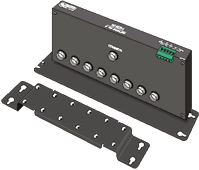This product is no longer available and has been replaced by:SDM8X50.

| Services Available | |
|---|---|
| Repair | Yes |
| Calibration | Yes |
| Free Support | Yes |
Overview
The SDMX50SP is one of three 50 ohm, coaxial, 8:1 multiplexers that can be used in a TDR100-based system. It consists of a surge-protected multiplexer circuit board enclosed in a metal housing and a separate strain-relief bracket. Both the multiplexer housing and strain relief bracket have holes drilled at a 1” spacing. This allows the SDMX50SP to be mounted onto a wall or attached to the backplate of a user-supplied enclosure or Campbell Scientific enclosure (e.g., ENCTDR100, ENC12/14, ENC16/18).
Images

Specifications
| Multiplexer Housing Dimensions | 24.9 x 12.2 x 4.6 cm (9.8 x 4.8 x 1.8 in.) with mounts |
| Strain Relief Bracket Dimensions | 20.3 x 4.3 x 1.3 cm (8.0 x 1.7 x 0.5 in.) |
| Weight | 590 g (1.3 lb) |
Power Requirements |
|
| Input Power | 12 Vdc |
| Quiescent Current Drain | < 1 mA |
| Current Drain during Switching | ~ 90 mA (All multiplexers of the same level switch simultaneously for less than 1 s.) |
Documents
经常问什么estions
Number of FAQs related toSDMX50SP:6
Expand AllCollapse All
-
The clicking sounds come from mechanical relays making and breaking their contacts.
-
No. All SDMX50-series multiplexers in a TDR100 system may be connected to the same 12 V power supply.
-
These three multiplexers all use the same relay board, but the housing differs. The multiplexers are described side-by-side on page 2 of thisbrochure.
The most popular model is the SDMX50SP, followed by the SDMX50.
-
PC-TDRis a free download in the Downloads section ofthe PC-TDR web page..
-
In applications where TDR probes are used to measure soil water content, the maximum distance from the TDR probe back to the TDR100/TDR200 (even through one or more multiplexers) cannot exceed 15 m (50 ft) when using RG58 coaxial cable; the CS605-L, CS630-L, and CS640-L TDR probes have an RG58 cable. When using low-loss coaxial cable, the distance cannot exceed ≈25 m (80 ft); the CS610-L, CS635-L, and CS645-L TDR probes have a low-loss coaxial cable.
In slope stability and rock mass deformation applications, the maximum coaxial cable length should not exceed ≈1 mile (5,280 ft). The maximum combined length of all SDM cables in the system should not exceed ≈76 m (250 ft).
Privacy Policy Update
We've updated our privacy policy.Learn More